Key takeaways:
- Audio descriptions enhance accessibility for individuals with visual impairments, allowing them to fully experience visual content through detailed narration.
- These descriptions enrich storytelling by revealing nuances and emotions, creating a deeper connection for all viewers, not just those who require accessibility features.
- Many popular platforms, including Netflix, Disney+, YouTube, Hulu, and Amazon Prime, have integrated audio descriptions, expanding access to diverse audiences.
- The emotional and immersive experience provided by audio descriptions transforms how stories are perceived, often revealing richness and depth previously unnoticed.
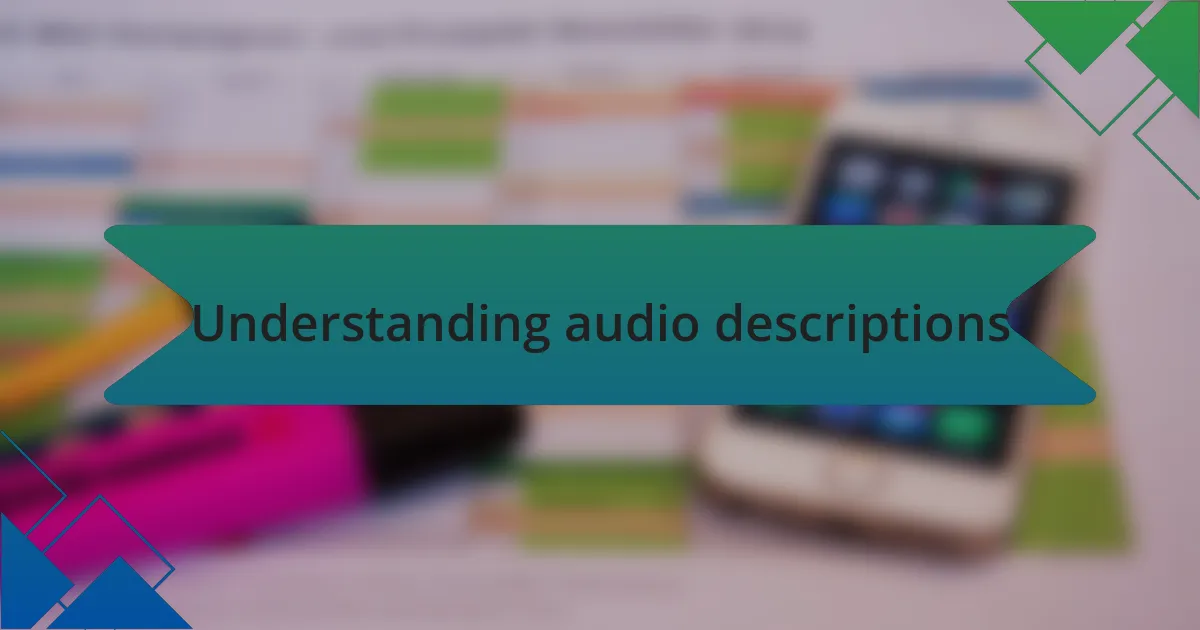
Understanding audio descriptions
Audio descriptions are a powerful tool that enhances accessibility, allowing those with visual impairments to experience visual content more fully. I still remember the first time I encountered this feature while watching a film. Suddenly, the scenes opened up to me in a way I had never expected, as the narrator vividly described actions, facial expressions, and subtleties that I would have otherwise missed.
Imagine trying to enjoy a movie without being able to see the expressions of the actors or the beauty of the cinematography. I felt a wave of emotions as the audio description brought the story to life, painting a picture in my mind. It was such a revelation to realize how much richer an experience could be with just a few carefully chosen words.
Understanding this aspect of media highlights an essential question: What does it mean to truly experience a story? Through audio descriptions, I discovered that inclusivity isn’t just about providing access; it’s about sharing the joy and nuances of storytelling with everyone. Each carefully crafted description felt like a bridge, connecting me to the world of visual storytelling in a meaningful way.
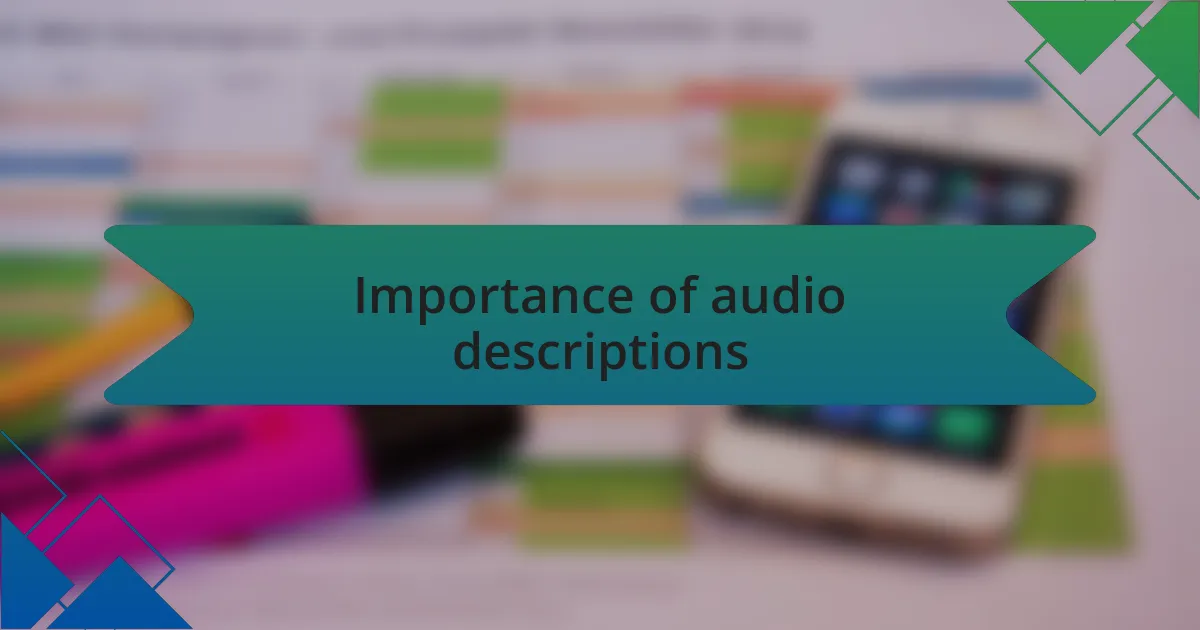
Importance of audio descriptions
Audio descriptions play a crucial role in fostering inclusivity in media. When I first experienced them during a live theatre performance, it felt like someone was guiding me through the visual tapestry before me. The narrator’s voice captured the set design, the actors’ movements, and even the tiny gestures; I couldn’t believe how much more alive the experience became. Can you imagine how many moments of joy individuals with sight impairments miss without this essential feature?
Beyond mere accessibility, audio descriptions enrich storytelling by revealing nuances that might otherwise go unnoticed. I vividly recall watching an animated film with my visually impaired friend; the descriptions not only provided context but also deepened her understanding of character motivations and subtle dynamics. It was a beautiful moment, watching her laugh and react as the narrator unfolded layers of meaning. Isn’t it incredible how something as simple as descriptive audio can transform passive watching into an engaging experience?
Moreover, audio descriptions promote empathy and awareness among all viewers. After I had the chance to discuss the experience with my friends, I realized how much it had opened their eyes to the challenges faced by those with visual impairments. It sparked a meaningful dialogue on accessibility in media, making me realize that audio descriptions are not just for those who need them; they enrich everyone’s experience. I wonder how many stories could be shared if more creators embraced this powerful tool?
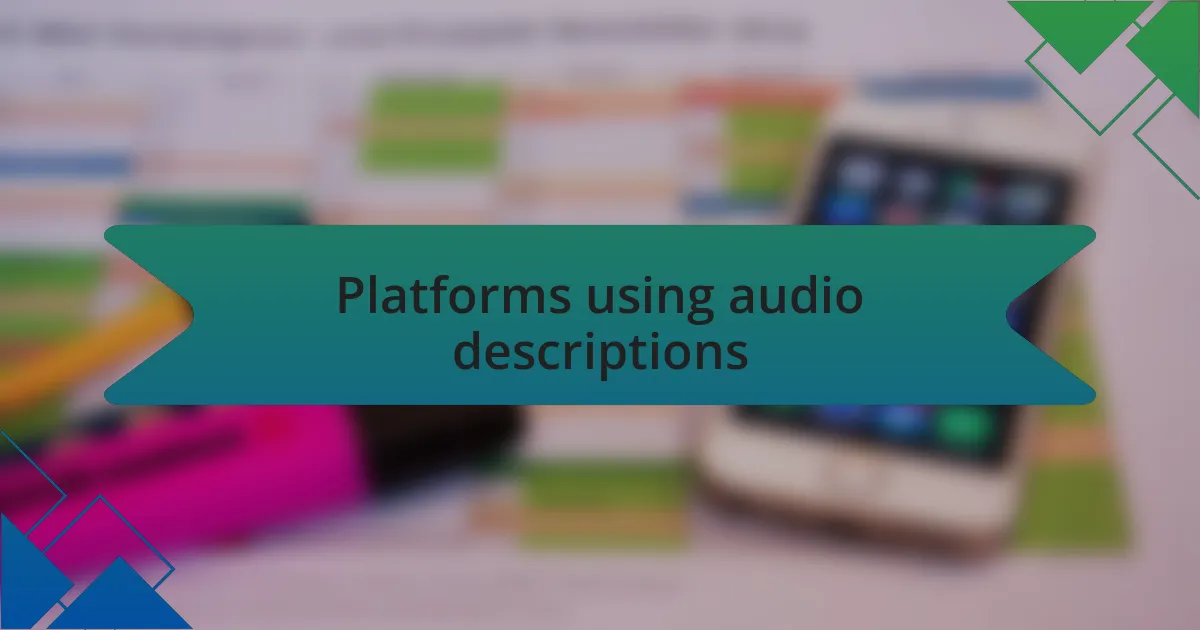
Platforms using audio descriptions
Many platforms have embraced audio descriptions, making content more accessible and enjoyable for everyone. For example, streaming giants like Netflix and Disney+ have integrated audio descriptions into their offerings. I still remember the first time I navigated Netflix’s audio description feature; it felt as though the stories were now open to my visually impaired friends and family, too.
YouTube has also stepped up its game by incorporating audio descriptions in selected videos. I came across a travel vlog that detailed landscapes and local customs. Hearing the narrator vividly describe the scenery added a profound layer to the visuals, allowing me to appreciate the beauty of the location in a whole new way. Have you ever found a video that transformed your perception through descriptive audio?
Meanwhile, platforms like Hulu and Amazon Prime provide users with a choice to enable audio descriptions, significantly expanding the reach of their content. I was thrilled when I discovered that a recent documentary series I loved featured this option. It heightened my understanding of the narrative, nurturing empathy not just for the subjects but for the diverse audience it could now engage. Isn’t it heartening to see how technology can bridge gaps between different experiences?
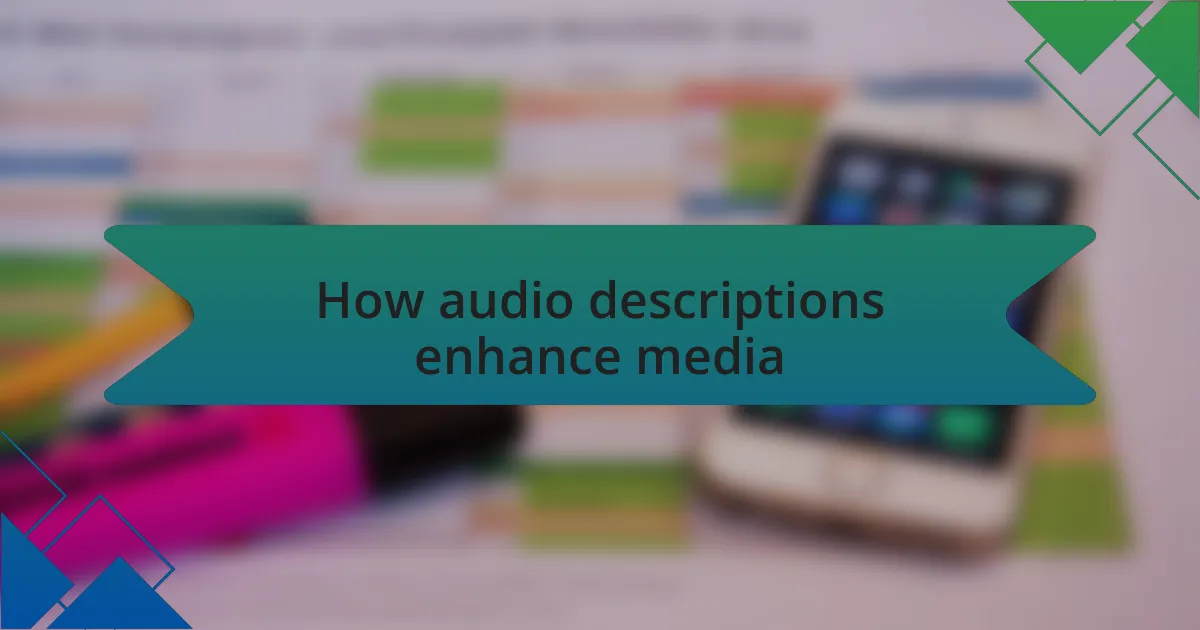
How audio descriptions enhance media
When I think about how audio descriptions elevate media, I can’t help but reflect on the way they transform storytelling. For instance, during a recent movie night, I turned on the audio description track for a film I had seen before. Hearing the nuanced descriptions of character actions and settings gave me a fresh perspective. It felt like I was experiencing the film through new eyes, are you curious about how storytelling can shift when you add that extra layer?
Audio descriptions not only enhance the viewing experience for individuals with visual impairments but also enrich the media for everyone. I recall watching a documentary filled with stunning visuals and intricate details. The audio description painted a vivid picture of each scene and, unexpectedly, I found myself fully immersed in the narrative. It was as if the filmmaker had included a guide specifically to enhance my understanding—who wouldn’t appreciate that deeper connection with the material?
Moreover, the emotional depth that audio descriptions can provide is often overlooked. I remember watching a poignant scene in a drama, and the audio description eloquently articulated the subtleties in the characters’ expressions and gestures. This added layer of context created a more profound emotional resonance for me, and I realized that the impact of the scene lingered much longer. How often do we miss out on rich experiences simply because we don’t engage with the tools available to us?
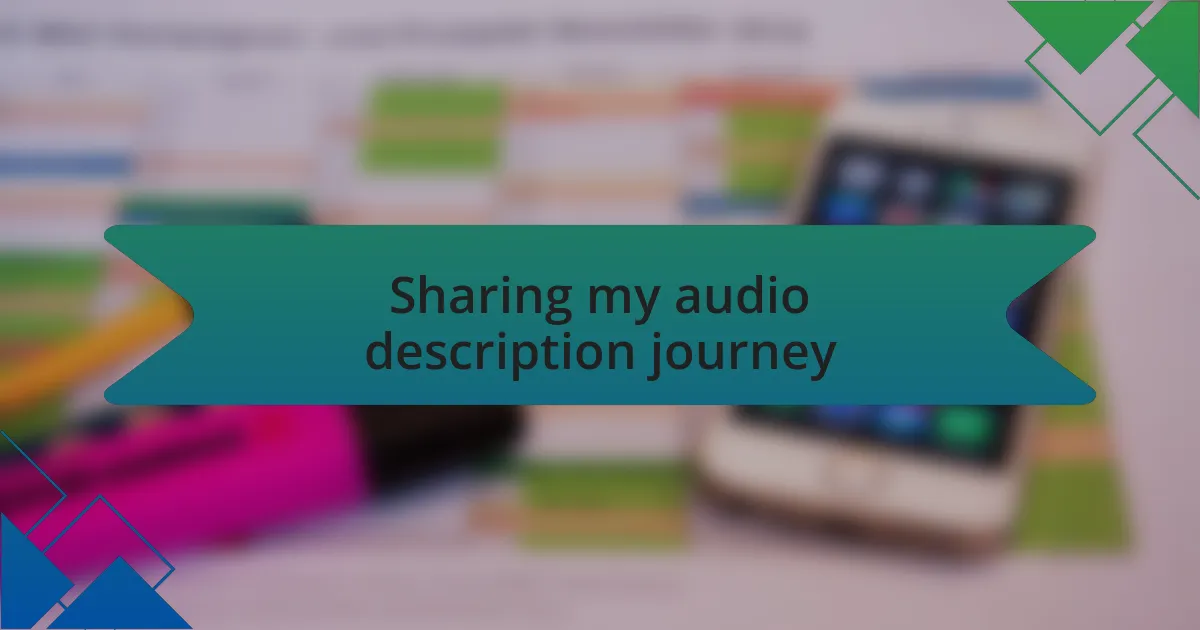
Sharing my audio description journey
Sharing my journey with audio descriptions has been nothing short of enlightening. I vividly recall the first time I stumbled upon this feature while browsing a streaming service—I was intrigued yet skeptical. Would it really change my viewing experience? As soon as I pressed play, I was captivated; the descriptions were like a secret language, unlocking details I hadn’t noticed before. It’s a remarkable feeling when a simple feature shifts your perspective so drastically.
One particular instance I cherish occurred while I was watching a classic animated film. The audio description brought the colorful animation to life, describing not just the visuals but also the tone of each character’s voice. At one point, a character was laughing, and the narrator conveyed not just the sound but the joy vibrating through the scene. It was a little moment, but it filled me with happiness—how often do we find simple joys in the tiniest details?
As I continued to explore different genres, I found that each film or show offered its unique palette of emotions with audio descriptions. I remember sitting down to watch a thriller, and the descriptions heightened my tension with insightful cues about what’s happening off-screen. It was exhilarating! That experience made me realize how audio descriptions don’t merely serve a functional purpose; they elevate the entire emotional landscape of the story. Can you recall a moment when the details made all the difference in how a story impacted you?